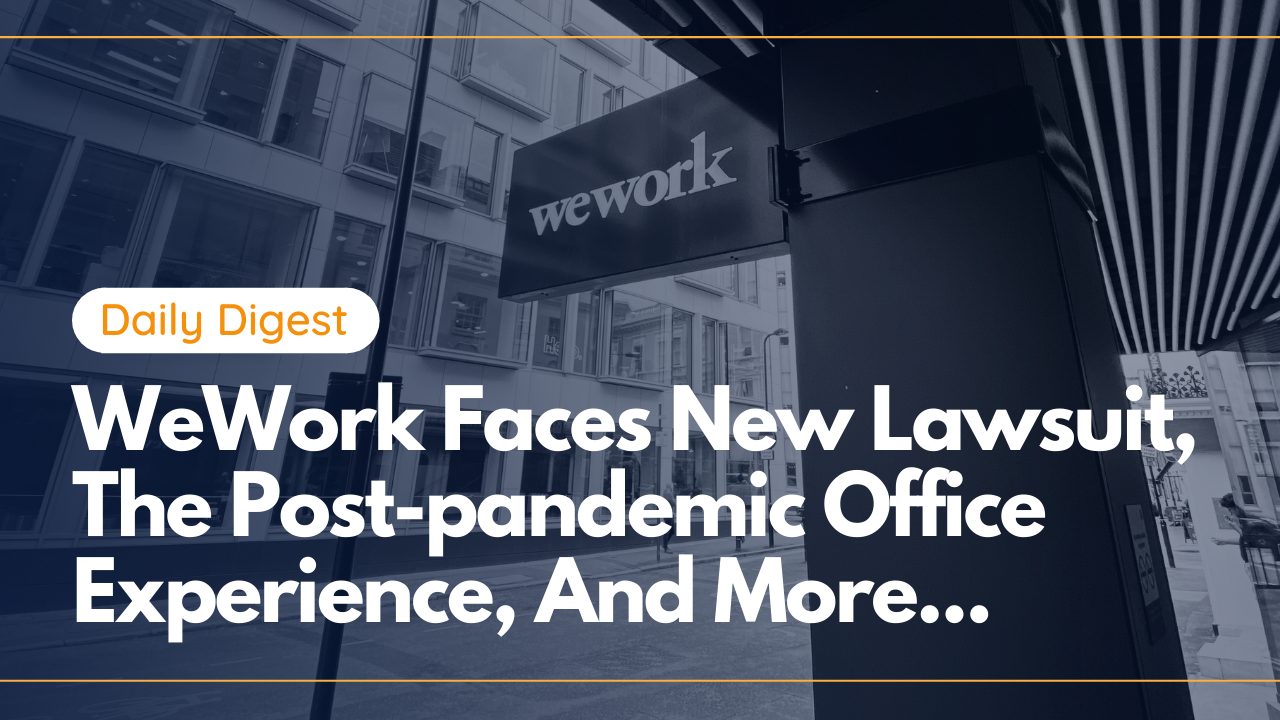Hand selected flexible workspace news from the most reliable sources to keep you ahead of the pack. We find all the latest news, so you don’t have to. Morning and afternoon updates. Stay in the know.
Here’s what you need to know today:
- WeWork Faces Lawsuit By New York Landlord
- How Companies Are Establishing New Flexible Policies
- Interest Across CRE Assets Is Growing
- Finding Balance In The Post-pandemic Office Experience
- Avoiding Exclusion In The Workplace
- The Risk Of A Two-Class Employee System
WeWork Faces Lawsuit By New York Landlord
New York-based Walter & Samuels have filed a lawsuit against WeWork for reportedly trying to move its tenants to another location after defaulting on its lease with the landlord.
The Chelsea landlord, which owns 214 West 29th Street, filed the suit last week in New York Supreme Court in an effort to recoup its damages, which they estimate would amount “in excess” of $37 million.
According to the lawsuit, WeWork defaulted on its lease after not paying a $584,500 security deposit. It also claims the coworking company is in default since it never replenished a deposit account after Walter & Samuels withdrew WeWork’s past due rent for January and February of this year.
Walter & Samuels allege that they are entitled to take over WeWork’s subtenants if it defaulted on its lease since it invested “tens of millions of dollars” to build out the space for the operator.
The 15-year lease signed in 2018 allowed WeWork to take up 100,000 square feet in the building and aimed to accommodate enterprise members that require higher-quality layouts and HVAC systems.
In June of 2020, the landlord provided the fourth floor of the building to WeWork for occupancy, but instead of paying a security deposit for the space, the coworking operator asked the landlord to take back the space. If the landlord refused, WeWork stated it would abandon the entire building.
How Companies Are Establishing New Flexible Policies
The time to navigate future working models has arrived. As a result of the changes that the workforce has undergone in the past year, many businesses are turning to a hybrid model to accommodate the new needs of workers.
With these adjustments, businesses are working to establish more structured flexible policies in order to make the transition as seamless as possible.
“It has to be flexible enough so people can see you’ve listened, but clamped down enough that you don’t have hundreds of people off at the same time when it may affect productivity and collaboration,” said Graeme Canter, managing partner and director of operations for media agency MediaCom U.K.
This will likely include a slow reopen of offices, Covid-19 protocols still in place such as temperature checks and face masks, staggering start times and reduced occupancy.
Because workers are no longer geographically tethered to large cities, many have started moving to secondary cities and the suburbs for a lower cost of living and more space. This has opened the door for companies to make changes to their real estate footprint.
For instance, the CEO of UK-based Neo PR Ashley Carr closed the company’s Buckinghamshire office and converted a former stable block on his farmland to serve as the agency’s “touchdown space.”
“We don’t even call it office space anymore,” said Carr. “I find the concept of the standard office just a lazy way to create culture. Now is the time for businesses to be more flexible.”

Interest Across CRE Assets Is Growing
New data from Real Capital Analytics finds that investor interest across all commercial real estate asset classes is growing, but suburban assets are seeing the most interest.
In fact, suburban office growth grew to a 3.6% annual pace in March, while urban assets declined by 2.4% year-over-year.
High-end assets across established markets saw $10.5 billion in quarterly sales, with Dallas, Manhattan and San Francisco accounting for almost 25% of the total sales.
Overall CRE activity grew in March, with most sectors seeing increased volume. While deal volume was up 11% year-over-year during this time, deal activity was actually down 30% compared to the first quarter.
Sales across the office, industrial and multifamily sectors all increased, while the hotel industry saw an even higher spike. The sales of individual properties within the industrial sector reached a record of $14.4 billion the first quarter of this year, with Dallas leading constructions at 67% year-over-year.

Finding Balance In The Post-pandemic Office Experience
Remote and hybrid work models are no longer a far-fetched concept — they’re officially reality.
Companies large and small have committed to adopting more flexible work policies in the future, with a Global Work-from-Home Experience Survey estimating that 25% to 30% of the workforce will work remotely multiple days each week.
Although these arrangements are in high demand and carry their own benefits, there is still a need to balance this shift with a physical office, which is valuable to workplace culture. If the past year has taught anything, it’s that certain aspects of the workplace cannot be replicated virtually.
For instance, the mass transition to working from home has had a direct impact on the emotional wellbeing of employees as they’ve grown increasingly lonely. In fact, a study from Twingate found that 65% of remote workers admitted they feel lonely.
Subsequently, this can have a direct impact on work performance. While there have been indications that remote working can boost productivity, some companies have cited that culture loss and reduced productivity are the main reasons for them to shit to a hybrid model.
Finding balance seems to be the end goal for many organizations. While companies want employees to enjoy the newfound perks of remote working, leaders are also looking to accommodate those who miss the connection and socialization that a physical workplace provides.

Avoiding Exclusion In The Workplace
Teamwork is the foundation of any well-oiled company, but more people are feeling that they do not fit in with their team. Wanting to be included is a basic human need, and without it, both workers and businesses suffer.
A sense of belonging is central to a healthy workplace environment. With research from BetterUp finding that one in four employees don’t feel like they belong, leaders need to take action in order to improve team performance.
Luckily, nurturing a sense of belonging among workers isn’t complicated. It simply takes listening to employees, having awareness and leading with an empathetic approach.
For starters, acknowledging any exclusions that are happening can help empower team members. If leaders take note that someone’s ideas aren’t being valued or heard, engage in conversation about the situation and give them the space to fully flesh out their experience, ideas and feelings.
Being proactive is also ideal for a truly inclusive workforce. Building culture can mean having a set-in-stone employee experience policy that helps mitigate any risk of excluding workers.
For instance, leaders should always ask themselves if they have heard from every team member after meetings. Then, be deliberate and invite those who may have not been able to contribute much into discussions. At the same time, always praise allies who are supporting and sticking up for their colleagues.

The Risk Of A Two-Class Employee System
A UK study revealed that those who worked from home between 2011 and 2020 were less than half as likely to be promoted and put in an average of 6 hours of unpaid overtime in 2020.
The unfortunate reality is that many at-home employees are treated differently than their in-office counterparts, leading them to feel more stress and pressure in the workplace.
With few employees slowly returning to the office for portions of the week, they are likely to renew old connections with colleagues that they have not seen in-person in well over a year. However, those who are at home could miss out on this sense of community.
Additionally, some managers may view the people who choose to return to the office as more dedicated to their jobs and naturally focus on employees who are physically present.
Those who are especially skeptical of a remote employees’ workload could implement surveillance technologies to see how much these staff members are actually working, leading them down the path of unhelpful micromanagement tactics.
Starting now, business leaders need to take measures to avoid creating this two-class system that is at high risk of emerging.
This should include keeping remote staff in the loop of any and all new developments, provide them with the necessary tools and furniture for at-home environments and remember that remote workers are often just as dedicated to their work as their in-person counterparts.



 Dr. Gleb Tsipursky – The Office Whisperer
Dr. Gleb Tsipursky – The Office Whisperer Nirit Cohen – WorkFutures
Nirit Cohen – WorkFutures Angela Howard – Culture Expert
Angela Howard – Culture Expert Drew Jones – Design & Innovation
Drew Jones – Design & Innovation Jonathan Price – CRE & Flex Expert
Jonathan Price – CRE & Flex Expert














